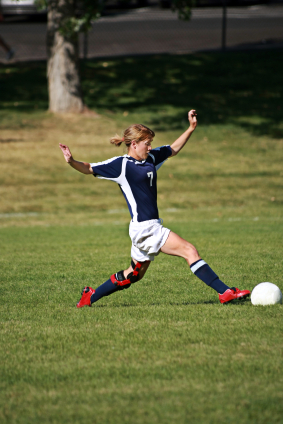Female adolescent soccer players who followed a 15-minute neuromuscular warm-up program twice a week in training over the course of a season experienced a 64% reduction in the rate of anterior cruciate ligament (ACL) injury compared to players who did not follow such a program, according to a 2012 Swedish study.1

The researchers followed a total of more than 2,500 players aged 12 to 17 over the course of a seven month season in 2009. Players in the intervention group were asked to perform a 15-minute neuromuscular warm-up program at two training sessions a week, while players in the control group did not.
The warm-up program, similar to other programs, consisted of six exercises focusing on knee control and core stability:
- One legged knee squat;
- Pelvic lift;
- Two-leged knee squat;
- The bench;
- The lunge; and
- Jump/landing technique.
Results
The researchers found a "15 minute neuromuscular warm-up programme reduced the overall rate of anterior cruciate ligament injury in adolescent female [soccer] players by 64%" and a "preventive effect for severe knee injury and any acute knee injury in players who completed the program at least once a week."
Because most ACL injuries in soccer players are believed to result from non-contact injury mechanisms, neuromuscular training programs have primarily targeted non-contact injuries. An analysis of non-contact ACL injuries suffered by players in the current study, however, found no significant effect of the training regimen in reducing that type of injury, although researchers noted that five of the ACL injuries in the control group occurred during training, and all were of the non-contact variety.
This suggested, wrote lead author Markus Waldén of the Division of Community Medicine, Department of Medical and Health Sciences at Linköping University, that non-contact ACL injuries during training may be prevented by a neuromuscular training program, consistent with a previous study of female collegiate soccer players, in which the preventive effect was seen only for training-related anterior cruciate ligament injuries.2
Implications and applicability
Because the direct costs of surgery and hospital care for ACL reconstructive surgery are high, and additional costs are associated with non-surgical treatment, postoperative rehabilitation, and disability claims, "if almost two-thirds of the ACL injuries in adolescent female soccer players were avoided, this would substantially reduce the need for surgery and rehabilitation with large health economic benefits," Waldén wrote.
Whether the results of the study could be generalized to other age groups, male soccer players, or other team sports, he said, was uncertain, but given the preventive effects of similar neuromuscular programs in other randomized controlled trials in female collegiate soccer players2, team handball players (mainly female) and adult female soccer players, "assuming that the programme might also be effective in other [soccer] populations as well as in other sports is reasonable."
Revised warm-up exercise program used to prevent injury in young female soccer players3
| Exercise | Repetitions |
| I. Running Exercises, 8 minutes (opening warm up, in pairs; course consists of 6-10 pairs of parallel cones | |
| Running straight ahead | 2 |
| Running, hip out | 2 |
| Runing, hip in | 2 |
| Running, circling | 2 |
| Running and jumping | 2 |
| Running, quick run | 2 |
| II. Strength, plyometrics, balance, 10 minutes (one of three exercise progression levels each training session): | |
| The plank: | |
| Level 1: both legs | 3x20-30 seconds |
| Level 2: alternate legs | 3x20-30 seconds |
| Level 3: one leg lift | 3x20-30 seconds |
| Side plank | |
| Level 1: static | 3x20-30 seconds (each side) |
| Level 2: dynamic | 3x20-30 seconds (each side) |
| Level 3: with leg lift | 3x20-30 seconds (each side) |
| Nordic hamstring lower | |
| Level 1 | 3-5 |
| Level 2 | 7-10 |
| Level 3 | 12-15 |
| Single leg balance | |
| Level 1: holding ball | 2 x 30 seconds (each leg) |
| Level 2: throwing ball with partner | 2 x 30 seconds (each leg) |
| Level 3: testing partner | 2 x 30 seconds (each leg) |
| Squats: | |
| Level 1: with heels raised | 2 x 30 seconds |
| Level 2: walking lunges | 2 x 30 seconds |
| Level 3: one leg squats | 2 x 10 (each leg) |
| Jumping | |
| Level 1: vertical jumps | 2 x 30 seconds |
| Level 2: lateral jumps | 2 x 30 seconds |
| Level 3: box jumps | 2 x 30 seconds |
| III. Running exercises, 2 minutes (final warm up) | |
| Running over pitch | 2 |
| Bounding run | 2 |
| Running and cutting | 2 |
1. Waldén M, Atroshi I, Magnusson H, Wagner P, Hägglund M. Prevention of acute knee injuries in adolsecent female football players: cluster randomised controlled trial. BMJ 2012;344:e3042. doi: 10.1136.bmj.e3042 (published May 3, 2012).
2. Gilchrist J, Mandelbaum BR, Melancon H, Ryan GW, Silvers HJ, Giffen LY, et. al. A randomized controlled trial to prevent noncontact anterior cruciate ligament injury in female collegiate soccer players. Am J Sports Med 2008;36:1476-83.
3. Soligard T, Myklebust G, Steffen K, Holme I, Silvers H et. al. Comprehensive warm-up programme to prevent injuries in young female footballers: cluster randomized controlled trial. BMJ 2008;337;a2469 (doi:10.1136/bmj.a2569).
Revised October 12, 2012








